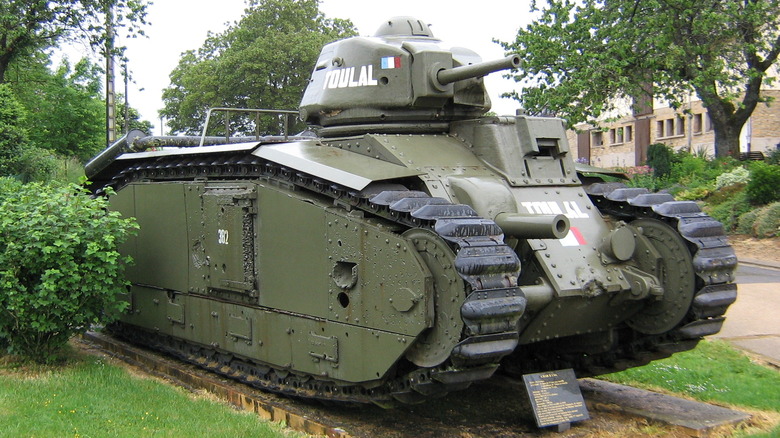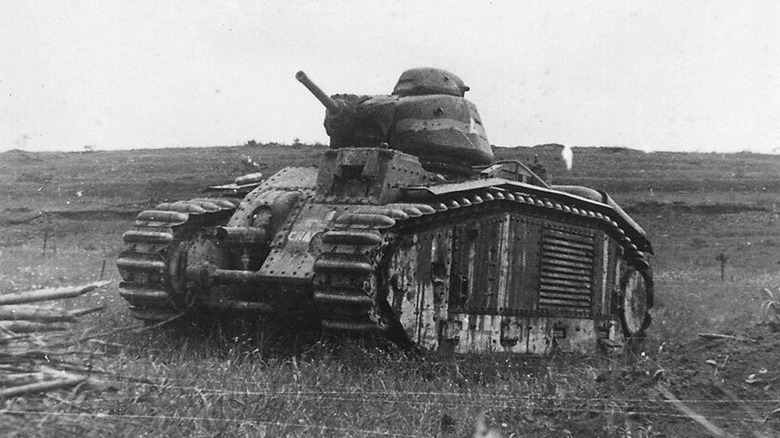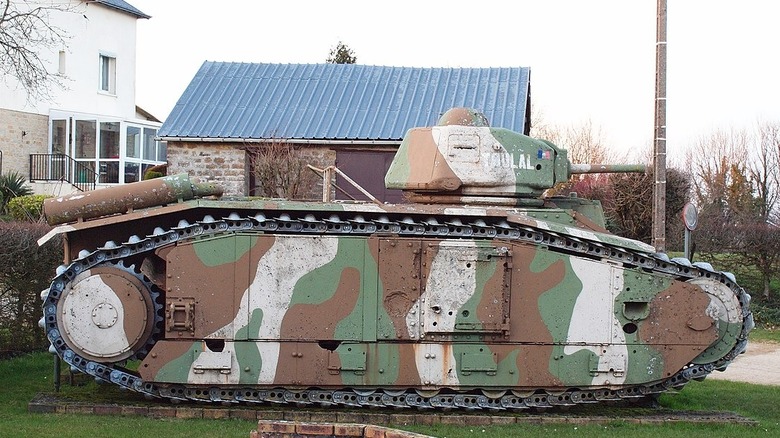What Made The Char B1 France's Best WWII Tank
Saying the Char B1 was France's best tank during World War II might sound incongruous, considering the European country (along with Luxembourg, the Netherlands, and Belgium) fell to the Nazi war machine in just six weeks.
However, despite not being able to stave off the superior German attack, it wasn't because France lacked the firepower. At the start of the war, Germany had roughly 3,200 tanks, while France had some 4,000. Nearly 800 of France's arsenal were Char B1 or B1 Bis variants.
The Char B1 was first drawn up during World War I (1919, to be exact) to support infantry and, when called upon, roll in as a heavy assault "Battle Tank" to take out artillery, bunkers, and engage other armored fighting vehicles (AFVs) directly. It had thick, heavy 40 mm (1.57 inches) armor and boasted a 75-millimeter howitzer and a top-mounted 47-millimeter gun.
By the time it reached the final production stage in the mid-1930s, however, it had undergone extensive design changes. The cost to build just one of them had soared to 1.5 million francs, making it the most expensive tank ever built.
The Char B1 is considered by many as the best Allied tank of WWII, so it wasn't that France had inferior tanks to the Nazis, but entirely different strategies. France failed due to poor strategic planning, discordant opinions within its military hierarchy, and a lack of execution.
[Featured image by The shadock via Wikimedia Commons | Cropped and scaled | Public Domain]
The Char ate Panzers for breakfast
One group thought having fewer heavily armored main battle tanks was the way to go. In comparison, the other group wanted to use swarms of lighter tanks to besiege the enemy — much like the Germans, who, instead of placing AFVs with infantry and cavalry tank units, formed whole divisions that would attack targets with overwhelming assaults.
While the Char B1 had 40 mm armor, the upgraded B1 Bis' front hull had armor that consisted of 60 mm bolted steel plates and was slanted at a 45-degree angle instead of the B1's 57-degree angle. The sides were upgraded to a 55 mm thickness, the back to 50 mm, and the engine deck to 25 mm. It was virtually impenetrable.
However, all this armor made it incredibly heavy — the B1 was 28 tons (56,000 lbs) and the Bis 31 tons (69,440 lbs). Both were very slow comparatively speaking, with the B1 having a road speed of just 17 mph (13 mph off-road), while the Bis was reportedly even slower.
While France may have lost the war, there were specific battles where the Char B1/B1 Bis, which according to the National Interest, "ate Hitler's best tanks for breakfast" — and, at least for a short time, struck real fear in the hearts of the German army.
A French tank strolls into a German ambush...
The Panzer II, equipped with a 20 mm gun, couldn't even leave a solid dent in the armor. Panzer IIIs, 38Ts, and IVs all had to be within 100 meters to have any chance of piercing the armor, and even then, the success rate was meager. An 88 mm flak gun once put 90 rounds into a Char, knocking off both main guns, and it still kept fighting.
The German army soon discovered that the only way to take out a Char was to get a Panzer IV and its 75 mm gun to nearly point-blank range. Sometimes, it took a coordinated effort between Stuka dive bombers, German artillery, and a group of Panzers to get one close enough.
Perhaps the Char's most famous battle occurred in the early morning of May 16, 1940, in the French town of Stonne. The previous day, the small town had been all but devastated by three squadrons of Stuka dive bombers and artillery from both sides as the two sides battled for control.
On the morning of the May 16, an entire company of German tanks from the 8th Panzer Regiment, consisting of eleven Panzer IIIs and two Panzer IVs, were deployed to Stonne to hold off further attacks.
[Featured image by Willi Ude via Wikimedia Commons | Cropped and scaled | CC BY-SA 3.0]
And leaves the heavyweight tank champ of the world
In trundled a single Char B1 Bis — the "Eure," commanded by Capt. Pierre Billotte, and driven by one Sergeant Durupt. Without hesitation, the Eure fired both its guns simultaneously, immediately destroying two German tanks that blocked and trapped many of the others.
The Panzer IIIs were already under-gunned and did little damage despite sending round after round into the Eure. Meanwhile, the IVs were too far away or out of position to do any good. The Eure advanced through the rubble-strewn streets, picking off Panzers until all thirteen tanks were destroyed. Still not finished, the Eure took out two 37-millimeter anti-tank guns.
Meanwhile, in another battle in Stonne, the Char B1 Bis "Riquewhir" ran through a column of German soldiers, forcing the 64th Schutzen Regiment to turn tail and retreat from the area entirely. By 7 a.m., two hours after the battle had started, the French had retaken the town.
When all was said and done, over 140 Panzer rounds had hit the Eure, denting its armor and ripping off chunks of plating. Yet, the crew was completely unharmed. Thus, the Char B1/Bis goes down as the single most legendary tank of WW2.
[Featured image by François GOGLINS via Wikimedia Commons | Cropped and scaled | CC BY-SA 3.0]


